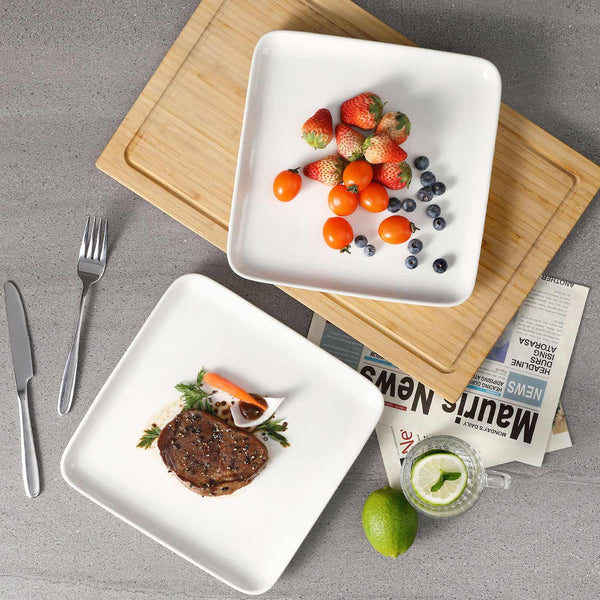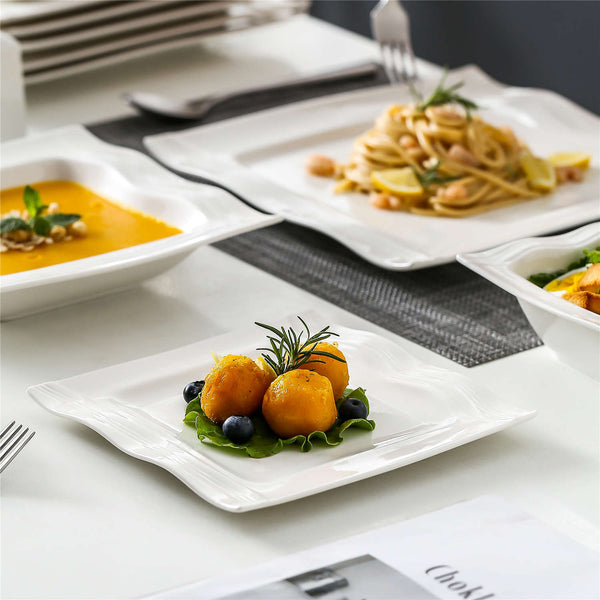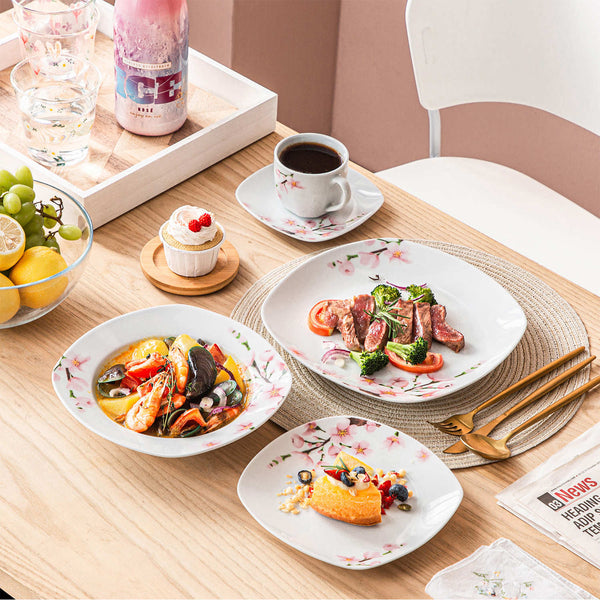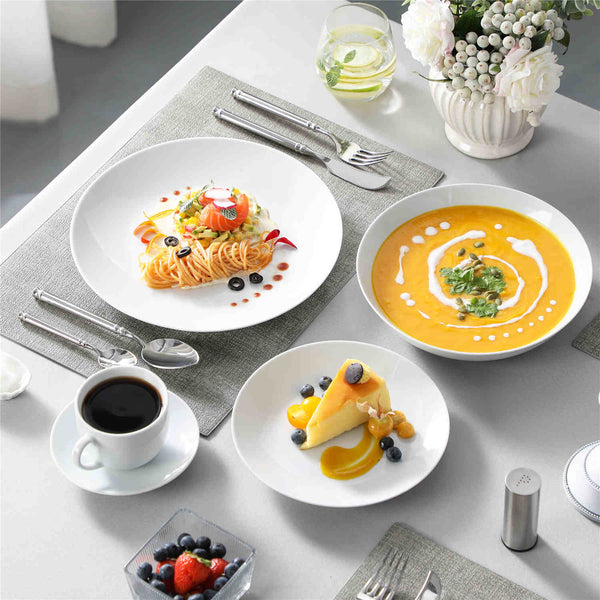Evolving Elegance: The Fusion of Tradition and Innovation in Porcelain Dinnerware
Navigation
- Traditional Craftsmanship of Porcelain Dinnerware
- The Perks of Porcelain Dinnerware
- Innovation in Porcеlain Dinnеrwarе: Linking up the Past with Modernity
- Sustainablе Practicеs: Towards an Eco-friendly Future
- Innovation In Porcelain Dinnerware By MALACASA
- Conclusion
Porcelain has been admired for centuries for its elegance and lasting appeal. It graces the tables as fine China and adorns the homes as fancy décor. Nevertheless, in recent years, the perception and use of porcelain have evolved significantly. Porcelain has come a long way from its traditional settings and is now used as a material for fashion and jewelry, giving a new lease to this ancient art. This exploration into porcelain dinnerware: a fusion of tradition and modernity is the way we plunge into the fascinating world of porcelain jewelry, revealing the amazing past of this art form, its modern twist, and the unexpected connections like the use of the words "cake topper" in this art.
Traditional Craftsmanship of Porcelain Dinnerware
Porcelain was developed in China over centuries, starting with the Shang Dynasty "proto-porcelain" pieces dating from 1600–1046 BCE. During the Eastern Han dynasty (25–220 CE), the first glazed early wares became porcelain, which the Chinese defined as high fire. Stoke-on-Trent has been the birthplace of creamy white bone china for 220 years. It is a mix of feldspar, quartz, and kaolin. They are fired in a kiln at temperatures up to 1400 degrees Celsius. Hence, they become hard, white, and nonporous pottery.
Types of Porcelain
Hard Paste Porcelain:
With its origins in China, this porcelain-making technique later spread to Japan. It is the culmination of porcelain craftsmanship. Among the earliest examples, Meissen porcelain was produced using a paste of kaolin and alabaster fired at high temperatures to achieve exceptional hardness, transparency, and strength. After those refinements, alabaster was replaced with feldspar and quartz, which allowed potters to fire at lower temperatures while maintaining quality. Kaolinite, feldspar, and quartz remain the enduring formula. Thus, it is the foundation on which the continental European hard-paste porcelains rest.
Soft Paste Porcelain:
The early European replicas of Chinese porcelain produced soft-paste porcelain, which was made from clay, frit, soapstone, lime, and other additives. Thus, these compositions have yet to attain the hardness and vitrification of real porcelain. However, developments that included kaolin, quartz, and feldspars produced better soft-paste porcelains. Fired at lower temperatures than the hard-paste porcelains, soft-paste types offer a graceful combination of attractiveness and functionality.
Bone China:
Bone china was first conceived in 18th century England as a competitor to the imported porcelain on the world market. Slightly influenced by the Chinese porcelain manufacturing techniques, early English bone china features bone ash, kaolin, and china stone. The modern formulation employing feldspars outside the UK has replaced the traditional china stone. Despite its complex history, bone china remains a symbol of refinement and craftsmanship, revered for its delicate visual characteristics and amazing strength.
The Perks of Porcelain Dinnerware
Porcelain Dinnerware is a perfect example of culture and is the best choice for any casual or formal occasion, such as dinners. The versatility of its combination with manifold design options, knock-down packaging, and practicality captures customer interest.
1. Stain Resistance:
Porcelain remains resistant to grease and food odors because it has no pores for it to seep through, unlike clay pots or melamine, which can absorb these substances and develop issues over time. The best quality coating, a well-known solution like RAK Porcelain product, can reverse oils and juices on plates and make the dinnerware easier to wash and maintain the porcelain look.
2. Hygienic Properties:
The nonporous nature of porcelain makes it an ideal choice for tableware due to its inherent hygienic qualities. It does not absorb grease, odors, or bacteria, ensuring that cleanliness is maintained. Top manufacturers focus on designs that are both user-friendly and incorporate advanced features such as antibacterial glazes, which help to safeguard the health of users by preventing microbial growth.
3. Heat Retention:
Fine quality porcelain is specially made to be good heat absorbers and retainers, enabling diners to keep their meals at the right temperature throughout the whole meal. This thermal insulation feature can lead to a much better dining experience because food stays tender and flavorful all the way through.
4. Thermal Shock Resistance:
While porcelain is much harder and more resistant to both thermal shocks and temperature changes than stoneware or melamine is, This toughness a quality of porcelain that makes it resistant to chipping and bacterial growth, and it can also withstand rapid changes in temperature from freezer to microwave, without compromising the integrity of the dinnerware.
5. Longevity and Durability
Ceramic dinnerware offers durability and resistance to breakage, which gives it a great advantage for various settings such as banquets, restaurants, houses, and other domestic uses. Porcelain is particularly strong against breakage, deterring the natural wear and tear that comes with regular use, which means porcelain heirlooms are inherited from generation to generation.
Innovation in Porcelain Dinnerware: Linking up the Past with Modernity
The use of digital technology has changed the way crockery businesses operate. Digital water printing, for example, has provided an opportunity for color and complex pattern design application directly on porcelain surfaces with a precision that was not previously attainable.
Automatеd processes can guarantee uniform quality throughout the production runs, which leads to а low dеfеct and wаstе rate. Moreover, the technological integration into design and production phases provides an opportunity for the market trends and consumer preferences to be reflected more adaptively, ensuring manufacturers bring new collections faster.
Sustainable Practices: Towards an Eco-friendly Future
With the increasing eco-awareness, the porcelain dinnerware industry is heading in the right direction of sustainability. Scientific advances have led to the creation of eco-friendly glasses and clay bodies, which are less harmful to the environment and reduce the energy required for the firing.
Energy consumption is also another very critical area where many innovations are making an impact. Utilizing more efficient kilns and alternative energy sources such as solar or biomass reduces the carbon emissions associated with porcelain production.
Innovation In Porcelain Dinnerware By MALACASA
MALACASA is at the top of the innovation in the porcelain dinnerware industry for its emphasis on quality, craftsmanship, and aesthetics. MALACASA focuses on the manufacturing of porcelain and ceramic dinnerware. Meanwhile, the brand is noted for its unique approach to tableware design, which allows the creation of a wide variety of products to upgrade home dining, hospitality, and restaurant areas.
MALACASA demonstrates precise craftsmanship and a continuous pursuit of innovation in porcelain dinnerware. For example, at a family gathering or party, Malacasa's porcelain bowls, plates, and cups can be coordinated by color, shade, and material. It is also worth noting that the floral watercolor tableware of MALACASA is exemplary of utilization and flexibility alongside these adjectives of resourcefulness and inventiveness in the porcelain dinnerware business.
Conclusion
In the production of porcelain dinnerware, non-Western society shows a combination of both innovation and tradition, leading to a very interesting result. In addition, making green processes is a dual commitment involving two components: environmental consciousness and the client's health.
Urbanization causes growing demand for porcelain dining tableware, changing preferences, and modern technologies that are the trigger for brands such as Malacasa. Many people prefer them because of the quality of the products they provide. Innovation will be the main driver of the future growth within the white ceramic dinnerware.









Leave a comment